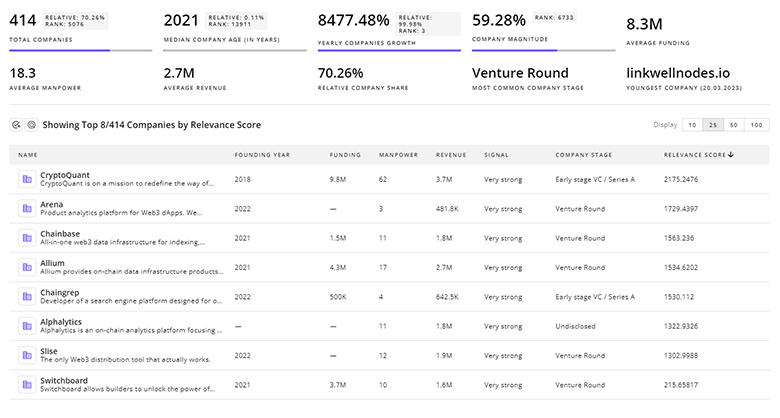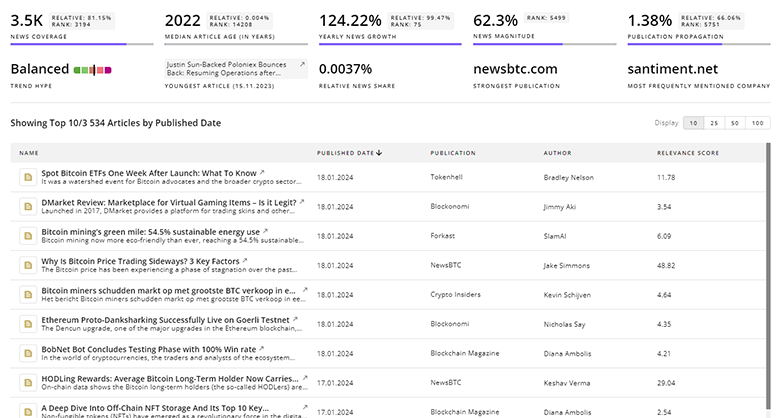
Natural Gas Technology Report
: Analysis on the Market, Trends, and TechnologiesThe natural gas technology market stands at USD 24.0 billion in 2024 and is projected to reach about USD 33.2 billion by 2030, driven by a 5.5% CAGR in core refueling and infrastructure segments and by a concurrent global build-out of liquefaction capacity (≈300 bcm/yr new LNG capacity by 2025) that is shifting trade flows and investment priorities. This combination of equipment & infrastructure demand, decarbonization constraints (methane control and CCUS), and fast-maturing conversion technologies defines where capital and product development will concentrate through 2030
We last updated this report 20 days ago. Tell us if you find something’s not quite right!
Topic Dominance Index of Natural Gas Technology
To gauge the impact of Natural Gas Technology, the Topic Dominance Index integrates time series data from three key sources: published articles, number of newly founded startups in the sector, and global search popularity.
Key Activities and Applications
Liquefaction, small-scale LNG and FLNG deployment — construction and retrofit of liquefaction trains, small-scale LNG plants and floating solutions to reach markets without pipelines; this drives demand for modular cryogenic systems and FSRUs/FLNG units and changes project timing and capex profiles.
So what: modular and floating approaches reduce time-to-market and preserve export optionality where onshore permitting is slow.Gas monetization and conversion (GTL, SNG, syngas, chemical feedstocks) — on-site conversion of stranded or flared gas into liquids or pipeline-quality methane and chemicals, including emerging catalytic and plasma routes.
So what: conversion technologies convert a waste liability (flared gas) into revenue streams and reduce emissions exposure.Renewable Natural Gas (RNG) and biogas upgrading — landfill, wastewater and agricultural feedstock upgrading into pipeline-quality RNG for injection or vehicle fuel, including patented containerized upgrading systems.
So what: RNG provides near-term low-carbon gas volumes with policy support and attractive offtake economics for fleets and utilities.Methane emissions detection and mitigation — deployment of advanced sensors (TDLAS, imaging), LDAR programs, and pressure/regulation systems to cut fugitive losses and meet tightening regulation.
So what: precise monitoring reduces regulatory risk and preserves the greenhouse-gas advantage of gas vs. coal.Hydrogen from methane (pyrolysis/reforming) and hydrogen blending — commercial pilots convert methane to hydrogen + solid carbon (pyrolysis) or low-carbon blue hydrogen with integrated CCUS, enabling use of existing gas infrastructure for hydrogen blends.
So what: hydrogen pathways protect existing asset value while aligning with decarbonization targets.
Emergent Trends and Core Insights
Supply reallocation and export capacity surge — ~300 bcm/yr of new LNG export capacity entering the market by 2025 is reorienting flows (U.S. gains largest upside) and creating buyer competition that benefits flexible, modular supply solutions Global Gas Report 2025.
So what: project sponsors must design contracts and assets for flexible spot participation rather than long-term pipeline pricing only.Price volatility shifts procurement strategies — sustained prices >$4/MMBtu in 2025 and higher spot activity force buyers toward shorter tenors and more spot exposure, altering project bankability for long-lead assets Natural gas – Price – Trading Economics.
So what: sellers need marketing agility and buyers need hedging and physical flexibility tools.Decarbonization binds product roadmaps — methane abatement, CCUS and RNG are now non-negotiable market requirements in many jurisdictions; integration of capture or low-emission hydrogen improves offtake access and financing terms Synthetic Natural Gas Market Research Report.
So what: technologies that lower lifecycle emissions command premium valuation and faster permitting.Digital operations and AI for asset efficiency — AI/advanced process control improves liquefaction and midstream uptime and trims capex through optimized design and predictive maintenance U.S. natural gas sector deals surge in 2025.
So what: digital solutions accelerate payback and reduce Opex, making marginal projects investible.Decentralized, modular deployment — small-scale LNG, virtual pipelines, and mobile/regas units enable rapid market access for remote customers and expedite monetization of small gas pools Gas Delivery System Market Research Report.
So what: this reduces need for long pipelines and lowers minimum project sizes.
Technologies and Methodologies
Methane pyrolysis (solid carbon + hydrogen) — modular reactors that produce hydrogen with low CO2 footprint and a stable carbon coproduct; high strategic value for industrial hydrogen supply chains.
So what: pyrolysis allows near-term hydrogen scale-up tied to existing gas supply.Advanced membranes and cryogenic CO2 removal — membrane separation and cryogenic distillation lower energy penalty for sour gas treatment and CO2 capture ahead of liquefaction or methanation Molecules – Cryogenic Distillation insights.
So what: cheaper purification improves feedstock flexibility and reduces operating costs for SNG/GTL projects.Modular liquefaction and mixed-refrigerant cycles — small-scale MRC and AP-X derivatives reduce capex per train and accelerate deployment of LNG in underserved markets Gas 2025 – IEA.
So what: modular liquefaction is the enabler for virtual pipelines and quick market entry.Digital twins, TDLAS and airborne/optical plume imaging — combination of continuous sensors, aerial imaging and virtual facility models for LDAR and operational optimization.
So what: these systems materially reduce emissions, compliance cost and reputational risk.Gas-to-liquids and catalytic direct methane conversion — new catalyst screening and plasma approaches target higher selectivity routes to fuels and chemicals from methane, reducing the cost of monetizing stranded gas.
Natural Gas Technology Funding
A total of 1.9K Natural Gas Technology companies have received funding.
Overall, Natural Gas Technology companies have raised $1.3T.
Companies within the Natural Gas Technology domain have secured capital from 5.2K funding rounds.
The chart shows the funding trendline of Natural Gas Technology companies over the last 5 years
Natural Gas Technology Companies
Rimere — Rimere focuses on methane pyrolysis and thermocatalytic reactors designed to produce hydrogen and solid carbon from methane feeds. The company develops compact reactors intended for deployment at midstream or on-site at gas fields, targeting emission-sensitive offtake partners and industrial hydrogen buyers; its approach reduces CO2 emissions relative to steam reforming by avoiding direct CO2 generation.
Modern Hydrogen — Modern Hydrogen commercializes modular electrified reforming systems that convert methane to hydrogen with integrated low-carbon power options. The company positions units for distributed hydrogen supply and for coupling to RNG feedstocks, seeking to lower logistics cost for industrial customers and hydrogen offtakers.
Onboard Dynamics — Onboard Dynamics supplies modular small-scale reformers and CNG/LNG fueling modules for remote operations and fleet refueling. Its product set emphasizes rapid installation and minimal permitting footprint to convert stranded gas or local biogas into vehicle fuel or small hydrogen supplies.
FlowCo — FlowCo develops advanced membrane and separation systems for high-CO2 and high-nitrogen gases, targeting low-energy CO2 rejection and methane recovery in difficult feed streams. The company's IP aims to lower both Opex and the need for large physical solvent systems in remote gas processing applications.
Upwing Energy — Upwing commercializes the Subsurface Compressor System™ to revitalize low-pressure mature gas fields by relocating compression downhole. This reduces surface infrastructure, increases recovery from marginal wells, and pairs with digital controls to optimize production from aging basins.
Enhance your understanding of market leadership and innovation patterns in your business domain.

12.5K Natural Gas Technology Companies
Discover Natural Gas Technology Companies, their Funding, Manpower, Revenues, Stages, and much more
Natural Gas Technology Investors
TrendFeedr’s Investors tool offers comprehensive insights into 3.0K Natural Gas Technology investors by examining funding patterns and investment trends. This enables you to strategize effectively and identify opportunities in the Natural Gas Technology sector.

3.0K Natural Gas Technology Investors
Discover Natural Gas Technology Investors, Funding Rounds, Invested Amounts, and Funding Growth
Natural Gas Technology News
TrendFeedr’s News feature provides access to 128.2K Natural Gas Technology articles. This extensive database covers both historical and recent developments, enabling innovators and leaders to stay informed.

128.2K Natural Gas Technology News Articles
Discover Latest Natural Gas Technology Articles, News Magnitude, Publication Propagation, Yearly Growth, and Strongest Publications
Executive Summary
Natural gas technology sits at the intersection of immediate market opportunities (LNG capacity growth, virtual pipelines, RNG scale-up) and policy pressures (methane control, lifecycle decarbonization). Commercial winners will combine capital-efficient modular hardware (small-scale LNG, pyrolysis or reformers, membranes) with digital operations and verifiable low-emission credentials. For investors and operators, the playbook is threefold: (1) prioritize technologies that lower lifecycle emissions to secure offtakes and finance, (2) design plant and contract structures for price and delivery flexibility, and (3) target modular deployments that convert stranded resources into cashflow quickly. The next five years will determine which conversion and detection technologies move from pilot to industrial scale and which business models capture the growing arbitrage between supply flexibility and decarbonization requirements.
We value collaboration with industry professionals to offer even better insights. Interested in contributing? Get in touch!












